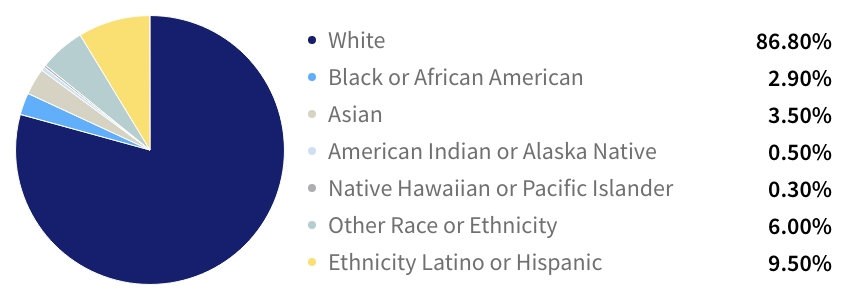How Diversity in Dental Hygiene Professions Helps Us All
Diversity in dentistry is proven to improve patient care, access, and comfort but it remains an elusive goal. There is a serious lack of diversity in dental hygiene, and it is exacerbated by an overall shortage of hygienists. However, by focusing on diversity, we could fill that shortage and improve care for all.
Breaking down the numbers on diversity in dental hygiene
Dental hygiene is one of the few professions where women significantly outnumber men. In fact, over 97% of all dental hygienists are female. While female representation is strong in this profession, it is less evident when it comes to diversity. Most dental hygienists are white.

Most likely, your dental practice doesn’t have a clientele that is 97% female and 86% white. You see a diverse range of patients and your workforce should be just as diverse.
How dental hygienist diversity helps patients and practices
Improving diversity in dental hygiene is not just about filling a high-need role. When we bring in more diverse dental professionals, we also improve patient comfort, access to care, and practice performance.
Access to care
Individuals of racial and ethnic minorities report poorer overall oral health and lower rates of preventative care treatment than their white counterparts. A big part of that is access. Individuals tend to open businesses in communities they are familiar with. With low diversity in the dental profession, we see fewer individuals opening locations that cater to their communities. Improving dental professional diversity from the top down would significantly expand access to care.
Patient comfort
About 36% of people report a fear of the dentist while 12% report their fear level is severe. Those numbers tend to be higher among Black and Hispanic patients who historically have poorer dental health and fewer preventative care visits. Greater diversity in the dental practice could put these patients at ease.
There’s also the concern of language barriers. Individuals with limited English proficiency (LEP) account for 10% of the population. Despite that, many dental practices must rely on translation relay services to serve these patients. Bilingual hygienists help LEP patients communicate directly and improve their overall comfort with care.
Diverse perspectives
Another benefit of diversity in the dental hygiene profession is the improvement of overall dental quality. Diverse perspectives and experiences among dental hygienists can lead to innovative approaches to patient care and treatment. By bringing in hygienists from diverse backgrounds, the profession can better serve a broader range of patients with unique needs and challenges.

What can you do to drive dental diversity?
Currently, many dental practices are struggling to hire staff, let alone implement new diversity initiatives. However, by focusing on diversity, practices can address both problems simultaneously. Traditional methods of recruiting and developing hygienists yield traditional candidates. You can bring more diversity to your practice by adapting your recruiting and retention methods.
- Work With Schools in the Community: Direct placement from dental hygienist schools in your community can be a fantastic way to attract more diverse candidates. One thing schools need is externship opportunities for their students. Creating an externship with your practice and that school establishes a direct pipeline for student placement.
- Develop From Within: You may already have staff working in nonclinical positions in your practice who may be interested in stepping into a hygienist career. In that case, you might consider creating a program to provide training to these individuals and get them certified.
- Volunteer: Many great nonprofits are specifically designed to serve the dental needs of underserved communities. Volunteering your time with one of them can be a wonderful way to make connections with the right candidates.
- Establish a Scholarship: You can also establish a scholarship specifically for diversity in dental hygiene. Offering a fixed amount to candidates to cover their educational expenses can draw attention to your practice. Even if the scholarship winner chooses not to work for you, you may be able to get connections through the visibility of the program alone.
- Hold Cultural Competency and Diversity Training: Training will help your staff members collaborate more effectively with patients from diverse backgrounds. There is a wide range of courses and conferences available to help better serve your patient base.
- Use Social Media: Social media platforms like LinkedIn and Facebook can be a terrific way to reach a wider audience when you are looking for hygienists. You can also use these platforms to show your workplace’s positive culture.
- Celebrate Diverse Holidays: Many offices and businesses stick to traditional American and European holidays and overlook ones celebrated by other communities. Adding in celebrations for Diwali, Hanukkah, the Lunar New Year, and other less-celebrated events is more culturally inclusive and fun for your staff.
Building diversity in dental hygiene is not about recruiting a specific type of candidate; it’s about embracing a diverse range of candidates. It is about building diversity into the foundation of your practice. Have a clearly documented diversity and inclusion plan, and continually seek ways to improve your service to patients. Through training, career development, and recognition, you can make dental care more accessible and comfortable for all.
An inclusive practice starts with a strong practice strategy. Your diversity and inclusion initiatives should be a pillar of your overall practice plan.
SPEAR NAVIGATOR
Transform how your practice runs by engaging the team through
coaching and training
A guided path to excellence through structured coaching and self-guided resources that will align your team, streamline processes and drive growth. Transform your practice by implementing Spear’s proven playbooks for developing and retaining a high-performing dental team.

By: Spear Team
Date: June 14, 2023
Featured Digest articles
Insights and advice from Spear Faculty and industry experts


